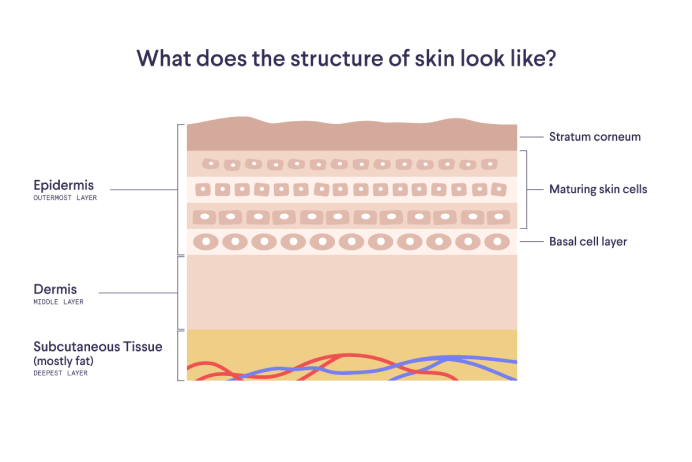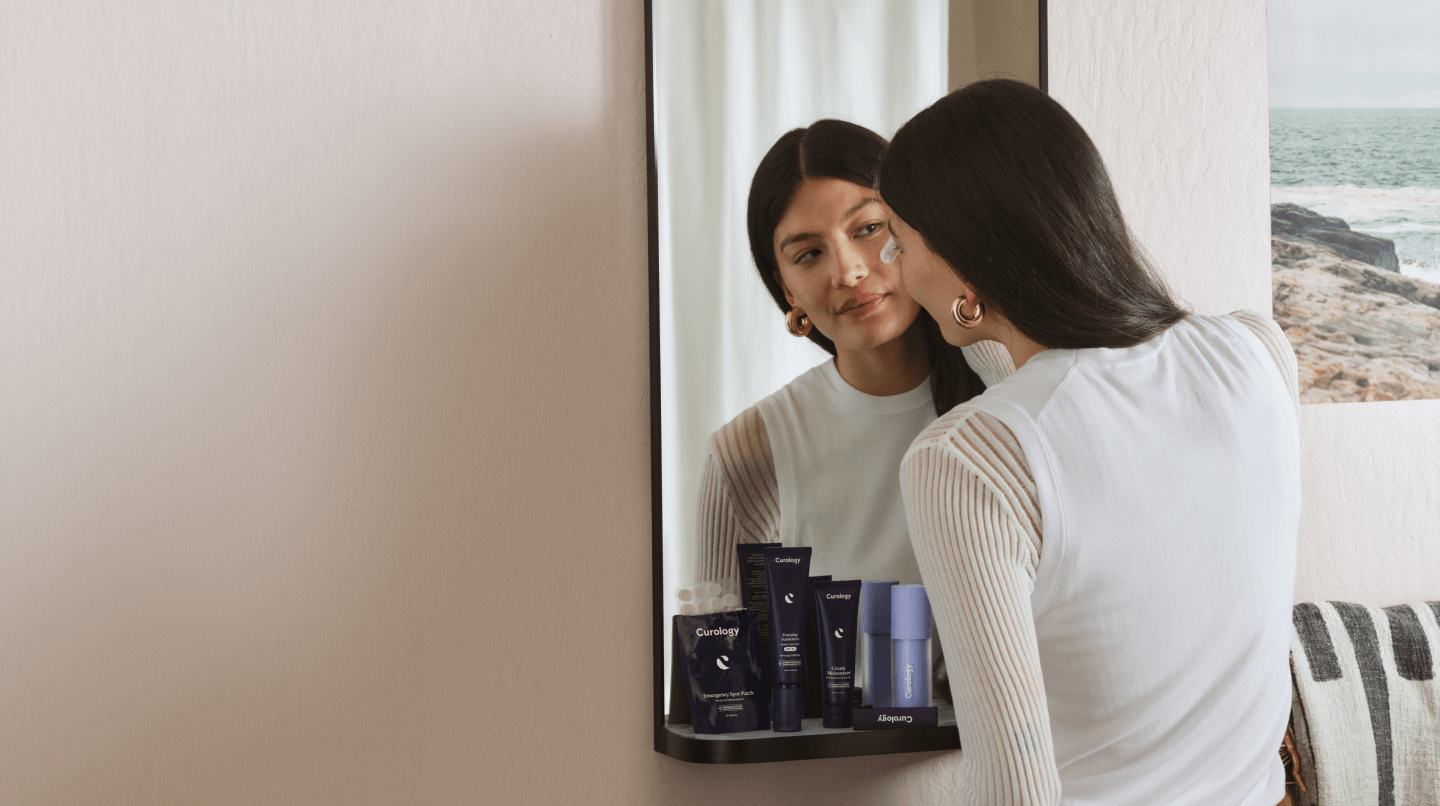How it works:
Share your skin goals and snap selfies
Your dermatology provider prescribes your formula
Apply nightly for happy, healthy skin
How it works:
How it works:
Share your skin goals and snap selfies
Your dermatology provider prescribes your formula
Apply nightly for happy, healthy skin
How it works:
Cell turnover and collagen production
We’ve got anti-aging skincare down to a science.



In the skincare world, so many products promise to boost collagen production, increase skin cell turnover, and “reverse” the signs of aging. The reality is, many over-the-counter anti-aging products promise results that the science doesn’t always back up.
In this guide, we’ll talk about the science behind the anti-aging skincare promises you’re likely hearing, from collagen production to cell turnover to the skin’s aging process. As a provider of prescription anti-aging skin treatments, we’re here to empower you to make the right decisions.
The body's natural aging process
As far as our skin’s cellular makeup is concerned, slowing down is a natural part of the aging process. As we age, the skin produces less collagen and elastin—that’s the stuff that makes skin look firm, plump, or “youthful.” The skin cell turnover process begins to slow down, too. Collagen and elastin are key to maintaining the skin’s structure, so this is why wrinkles, crepey texture, and sagging can happen as we age.

Skin aging is a complex process that is influenced by a combination of factors:
Genetics and hormones — known as intrinsic factors
Sun exposure and pollution — known as extrinsic factors
Together, these factors can change the layers of the skin and lessen the skin’s ability to produce new cells. That’s why the best “anti-aging” skincare is to wear sunscreen and to avoid excessive sun exposure!
As a result of those intrinsic and extrinsic factors, the epidermis (the outermost layer of skin) thins as we age. The skin can begin to look a bit rough, or in some cases, may even have a scaly texture. This thinning process is part of what eventually leads to skin sagging, which happens to all of us. But a healthy diet, minimizing sun exposure (don’t forget to protect your neck!), and not smoking can help reduce or at least delay some of these changes for a while.
What does cell turnover mean?
“Cell turnover” is a biological process in which the skin sheds dead cells and replaces them with younger cells.

Think of a snake shedding its skin: that’s cell turnover happening, albeit a little more dramatically than in humans! As you can see in the illustration above, new skin cells are produced in the deeper layers of the skin while the older cells gradually move to the surface, where they’re sloughed off. Cleansing, exfoliating, chemical peels, and other treatments can remove the “dead” skin cells from the surface of your skin and help decrease roughness.
How to improve cell turnover
Retinoids (for example, retinol or tretinoin)
Retinoids are vitamin A derivatives and are naturally present in all living organisms. In a topical prescription form, retinoids (such as tretinoin) help with the turnover of living cells on the skin’s surface and deep in the pores. “Tretinoin helps the cells to mature in a regular way, so that some aren’t maturing at a different rate than others and getting clogged up in the follicle,” says Curology provider Nicole Hangsterfer PA-C.
AHAs and BHAs

AHAs (alpha hydroxy acids) like glycolic acid are common in skin care products and help “unglue” dead skin cells—and in the process, refine dull, dry, or flaky skin and unclog pores. AHAs also help reduce hyperpigmentation and increase collagen synthesis within the deeper layers of the skin.
When applied, AHAs stimulate the exfoliation of cells in the top layer of skin. This results in the sloughing off of dull and rough skin and promotes cellular renewal. AHAs have been found to promote softer skin, diminish the appearance of wrinkles, fade age spots, and reduce blemishes. Another benefit of AHAs includes promoting collagen synthesis, which may help with firmness. (Disclaimer: AHAs can cause photosensitivity and should only be worn at night.)
Salicylic acid is an ingredient you’ve likely seen on plenty of skincare bottles, and for good reason. It’s a BHA—that’s beta hydroxy acid—and it can also help decrease inflammation. The fat-solubility of BHAs allows them to work deeper than AHAs, penetrating the follicle and reducing blocked pores. BHAs don’t cause photosensitivity, so you can use them during the daytime or nighttime (but we recommend wearing sunscreen during the daytime, anyway).
Vitamin C
Vitamin C is a potent antioxidant that stimulates collagen production to repair fine lines and wrinkles. It can also inhibit melanin formation, so it’s useful in treating hyperpigmentation. Use a vitamin C serum in the morning before sunscreen, or before bed for an overnight treatment.
Why antioxidants and anti-aging go hand-in-hand

Matcha green tea = antioxidants!
Ahhh, antioxidants! You’ve probably seen this word everywhere from beauty products to smoothie menus, but here’s why antioxidants benefit the skin. Antioxidants protect skin cells from environmental factors such as pollution and UV rays, which can contribute to signs of aging like wrinkles and sagging. This “attack” on the skin results in oxidative stress, and it sabotages your skin’s ability to renew and rebuild itself.
Your body naturally produces its own antioxidants, but you can also get them from external sources. Further study is still needed to say for sure whether the damage from oxidative stress can be counteracted by antioxidants we consume or apply topically, but that being said, it doesn’t hurt to use a topical product with antioxidant benefits. Vitamin C (mentioned above) is a powerful antioxidant, so using a topical vitamin C serum is a great way to get an antioxidant boost. Eating antioxidant-rich foods like berries and spinach may also help, so make sure to include lots of fruits and vegetables in your diet. Green tea is a great source of antioxidants, too, so that life-giving matcha latte in the morning is your friend (as long as it’s sugar-free).
Collagen myth-busting
Collagen is the most plentiful protein in the human body. In the skin, it helps maintain strength and firmness. Elastin, another protein found in skin, helps our skin stretch and recoil, maintaining its shape. To wrap your mind around elastin, think “elastic”—it helps give your skin “bounce.” Together, collagen and elastin help ward off wrinkles, fine lines, and sagging.
Over time, internal and external factors reduce your body’s ability to produce collagen and elastin. As we age and our levels of collagen and elastin start to decrease, that’s when we begin to see signs of aging.
Is it possible to increase collagen production?
There are lots of products out there that claim to improve collagen production in the skin or restore lost collagen, from collagen creams to drinkable collagen (like in bone broth). The reality is, these products don’t necessarily help the way you’d think they might. Collagen molecules in skincare products are far too large to be absorbed into the skin, so topical collagen products are likely of no benefit.

Collagen in your diet vs. collagen supplements
As for collagen supplements, we haven’t found sufficient evidence for improvement in skin elasticity, firmness, or wrinkling. Not to get too technical, but here’s how it works: the digestive system breaks down collagen into individual amino acids, whether the collagen is taken in the form of supplements or by ingesting protein-rich foods such as meat, cheese, eggs, or beans. If taking a collagen supplement does anything at all, it may not help any more than eating a helping of collagen-rich food—so maybe it’s not worth the extra time and money.
But, changes in collagen and elastin in the skin are impacted by diet. For example, “Eating too much sugar can damage the collagen in your skin,” says Curology provider Nicole Hangsterfer PA-C. “This means that sugar may contribute to signs of aging such as fine lines and wrinkles. So, a diet low in sugar can be a healthy choice for many reasons.” Our bodies can’t effectively repair collagen damaged by sugar, so the best way to prevent it is to follow a healthy, low-glycemic diet (which is generally a good idea, anyway).

Love your skin today and tomorrow
If you’re looking for a topical treatment that’s made to target your aging-related skin concerns, from fine lines to hyperpigmentation, we’re here for you.
Get your personalized skincare routine with Curology
Get your personalized skincare routine with Curology


Become a Curology member and take our quick-and-easy consultation online. If you’re a candidate, you’ll get your very own customized skin treatment prescribed by one of Curology’s medical providers. Start with a free 1-month trial (you only pay $5.45 for shipping and handling) and give it a try.*
We’re here to tell you what we know. That’s why our information is evidence-based and fact-checked by medical experts. Still, everyone’s skin is unique—the best way to get advice is to talk to your healthcare provider.
*Cancel anytime. Subject to consultation. Subscription is required. Trial is 30 days + $4.95 shipping and handling.

Curology Team
Related Articles
The 5 best chemical exfoliators for glowing skinWhich tretinoin is right for you, according to Vogue? How to help stop a rash from spreading, according to skin experts How to treat atrophic scars: Here’s what you need to knowA simple guide to skincare for menPopular Articles
Ask Curology: Is my cold breaking me out?Slugging: The dermatologist-approved skincare hack going viral on TikTokTretinoin vs retinol: What’s the difference?How to create a self-care routine that actually sticksYour 2023 skincare horoscopeTry prescription skincare
Get routine essentials


Face what’s next with Future-ProofRx
Face what’s next with Future-ProofRx
- Skin texture
- Fine lines
- Wrinkles
- Dark spots
- Dullness
$29.95/month